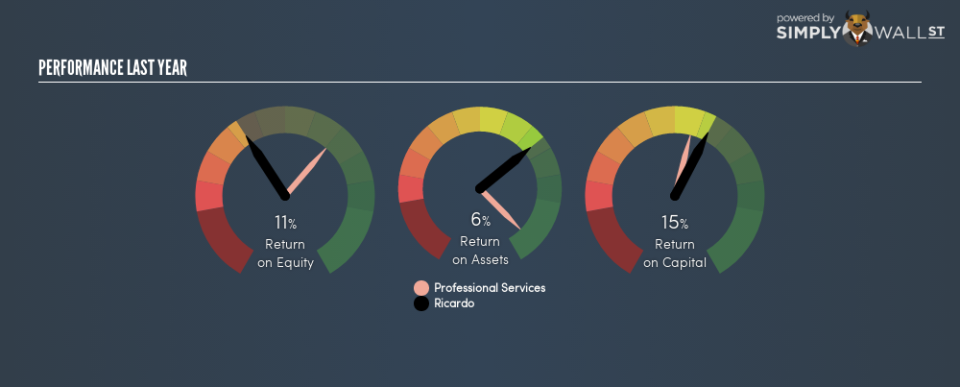Should You Like Ricardo plc’s (LON:RCDO) High Return On Capital Employed?

Today we are going to look at Ricardo plc (LON:RCDO) to see whether it might be an attractive investment prospect. Specifically, we’ll consider its Return On Capital Employed (ROCE), since that will give us an insight into how efficiently the business can generate profits from the capital it requires.
Firstly, we’ll go over how we calculate ROCE. Second, we’ll look at its ROCE compared to similar companies. Then we’ll determine how its current liabilities are affecting its ROCE.
What is Return On Capital Employed (ROCE)?
ROCE measures the amount of pre-tax profits a company can generate from the capital employed in its business. Generally speaking a higher ROCE is better. Overall, it is a valuable metric that has its flaws. Author Edwin Whiting says to be careful when comparing the ROCE of different businesses, since ‘No two businesses are exactly alike.’
How Do You Calculate Return On Capital Employed?
Analysts use this formula to calculate return on capital employed:
Return on Capital Employed = Earnings Before Interest and Tax (EBIT) ÷ (Total Assets – Current Liabilities)
Or for Ricardo:
0.15 = UK£36m ÷ (UK£340m – UK£102m) (Based on the trailing twelve months to June 2018.)
Therefore, Ricardo has an ROCE of 15%.
See our latest analysis for Ricardo
Want to help shape the future of investing tools and platforms? Take the survey and be part of one of the most advanced studies of stock market investors to date.
Is Ricardo’s ROCE Good?
ROCE is commonly used for comparing the performance of similar businesses. Using our data, Ricardo’s ROCE appears to be significantly below the 22% average in the Professional Services industry. This could be seen as a negative, as it suggests some competitors may be employing their capital more efficiently. Regardless of where Ricardo sits next to its industry, its ROCE in absolute terms appears satisfactory, and this company could be worth a closer look.
Remember that this metric is backwards looking – it shows what has happened in the past, and does not accurately predict the future. Companies in cyclical industries can be difficult to understand using ROCE, as returns typically look high during boom times, and low during busts. ROCE is, after all, simply a snap shot of a single year. Future performance is what matters, and you can see analyst predictions in our free report on analyst forecasts for the company.
Ricardo’s Current Liabilities And Their Impact On Its ROCE
Current liabilities include invoices, such as supplier payments, short-term debt, or a tax bill, that need to be paid within 12 months. The ROCE equation subtracts current liabilities from capital employed, so a company with a lot of current liabilities appears to have less capital employed, and a higher ROCE than otherwise. To counteract this, we check if a company has high current liabilities, relative to its total assets.
Ricardo has total liabilities of UK£102m and total assets of UK£340m. As a result, its current liabilities are equal to approximately 30% of its total assets. With this level of current liabilities, Ricardo’s ROCE is boosted somewhat.
Our Take On Ricardo’s ROCE
While its ROCE looks good, it’s worth remembering that the current liabilities are making the business look better. Of course you might be able to find a better stock than Ricardo. So you may wish to see this free collection of other companies that have grown earnings strongly.
If you are like me, then you will not want to miss this free list of growing companies that insiders are buying.
To help readers see past the short term volatility of the financial market, we aim to bring you a long-term focused research analysis purely driven by fundamental data. Note that our analysis does not factor in the latest price-sensitive company announcements.
The author is an independent contributor and at the time of publication had no position in the stocks mentioned. For errors that warrant correction please contact the editor at editorial-team@simplywallst.com.

 Yahoo Finance
Yahoo Finance 
